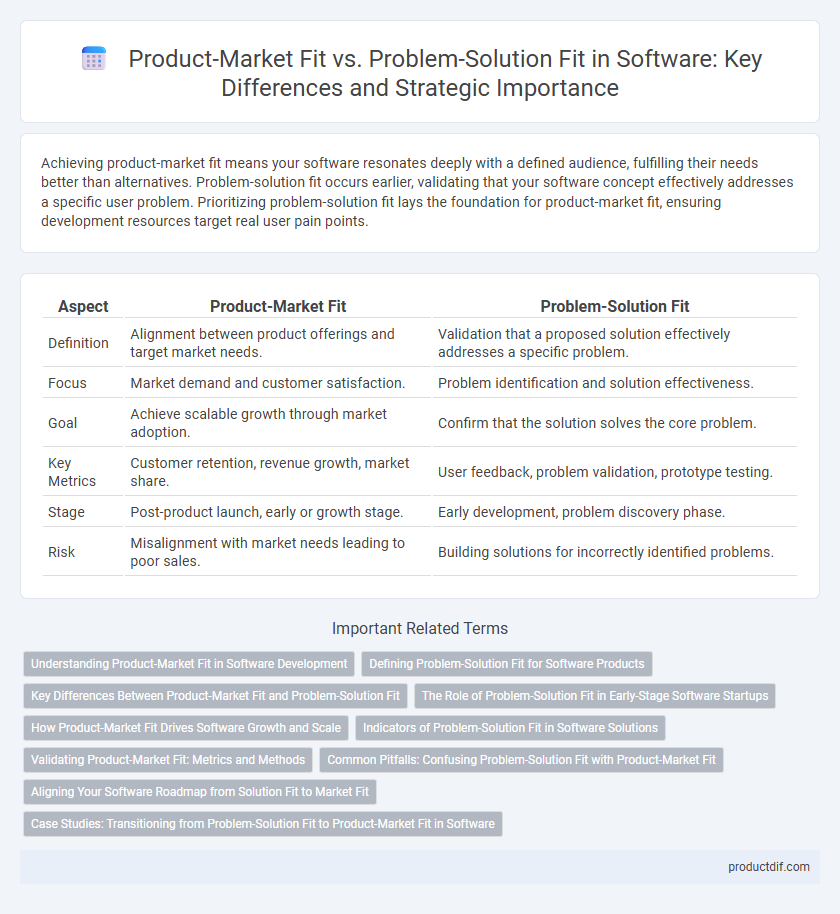Achieving product-market fit means your software resonates deeply with a defined audience, fulfilling their needs better than alternatives. Problem-solution fit occurs earlier, validating that your software concept effectively addresses a specific user problem. Prioritizing problem-solution fit lays the foundation for product-market fit, ensuring development resources target real user pain points.
Table of Comparison
| Aspect | Product-Market Fit | Problem-Solution Fit |
|---|---|---|
| Definition | Alignment between product offerings and target market needs. | Validation that a proposed solution effectively addresses a specific problem. |
| Focus | Market demand and customer satisfaction. | Problem identification and solution effectiveness. |
| Goal | Achieve scalable growth through market adoption. | Confirm that the solution solves the core problem. |
| Key Metrics | Customer retention, revenue growth, market share. | User feedback, problem validation, prototype testing. |
| Stage | Post-product launch, early or growth stage. | Early development, problem discovery phase. |
| Risk | Misalignment with market needs leading to poor sales. | Building solutions for incorrectly identified problems. |
Understanding Product-Market Fit in Software Development
Achieving Product-Market Fit in software development involves aligning a software product's features and user experience with the needs and preferences of a clearly defined target market. It requires rigorous user feedback analysis, iterative prototyping, and market validation to ensure the product solves real problems and gains traction among early adopters. Metrics such as user retention rate, engagement levels, and Net Promoter Score are critical indicators of successful Product-Market Fit in software projects.
Defining Problem-Solution Fit for Software Products
Problem-Solution Fit for software products occurs when a clearly identified problem is effectively addressed by a viable solution that meets user needs and pain points. Achieving this fit involves validating that the software's core functionality directly resolves user challenges, ensuring the product is both feasible and valuable. Successful Problem-Solution Fit lays the foundation for subsequent Product-Market Fit by confirming the solution's relevance before scaling or market expansion.
Key Differences Between Product-Market Fit and Problem-Solution Fit
Problem-Solution Fit occurs when a product effectively addresses a specific problem for a target audience, confirming the solution's value and relevance. Product-Market Fit, on the other hand, is achieved when the product meets the demands of a broader market, driving sustainable growth and customer adoption. The key difference lies in Problem-Solution Fit validating the problem's importance and solution viability, while Product-Market Fit confirms market demand and scalability potential.
The Role of Problem-Solution Fit in Early-Stage Software Startups
Problem-Solution Fit is crucial in early-stage software startups as it validates that the product effectively addresses a well-defined customer problem, ensuring initial market demand. Achieving strong Problem-Solution Fit enables startups to iterate rapidly based on user feedback, reducing development risks and optimizing resource allocation. This foundational stage lays the groundwork for Product-Market Fit by confirming the product's core value proposition resonates with target users before scaling efforts.
How Product-Market Fit Drives Software Growth and Scale
Product-market fit occurs when software solutions effectively address the demands of a target market segment, leading to increased user adoption and revenue growth. Achieving product-market fit enables scalable customer acquisition strategies, optimization of product features based on user feedback, and sustainable expansion in competitive software markets. This alignment between software capabilities and market needs drives accelerated growth, investor confidence, and long-term business scalability.
Indicators of Problem-Solution Fit in Software Solutions
Indicators of Problem-Solution Fit in software solutions include users engaging consistently with core features that directly address their key pain points and a clear reduction in customer complaints related to the targeted problem. High user retention rates combined with positive qualitative feedback pinpoint the effectiveness of the solution in resolving the identified issue. Metrics such as increased task completion rates and decreased time to value further validate the alignment between the problem and the software solution.
Validating Product-Market Fit: Metrics and Methods
Validating product-market fit involves analyzing key metrics such as customer retention rates, user engagement levels, and growth velocity to ensure a sustainable demand for the software product. Methods include conducting cohort analysis, assessing net promoter scores (NPS), and utilizing customer feedback loops to measure satisfaction and market fit precision. Employing A/B testing and market segmentation further refines the fit by identifying target user behaviors and preferences.
Common Pitfalls: Confusing Problem-Solution Fit with Product-Market Fit
Confusing problem-solution fit with product-market fit often leads startups to prematurely scale without validating market demand, resulting in wasted resources and missed user adoption targets. Problem-solution fit confirms that a product addresses a real user problem effectively, whereas product-market fit demonstrates that the product satisfies a strong market need with scalable demand. Recognizing this distinction prevents common pitfalls such as launching products lacking market validation or iterating solutions without identifying a viable customer segment.
Aligning Your Software Roadmap from Solution Fit to Market Fit
Aligning your software roadmap from problem-solution fit to product-market fit requires continuous validation of user needs and market demand through iterative development and customer feedback loops. Prioritize features that demonstrate clear value and scalability within target segments while refining the product based on quantitative metrics such as churn rate, customer acquisition cost, and lifetime value. Strategic alignment fosters adaptive roadmap planning, ensuring the software evolves beyond solving a problem to achieving sustainable market traction and competitive differentiation.
Case Studies: Transitioning from Problem-Solution Fit to Product-Market Fit in Software
Case studies on transitioning from Problem-Solution Fit to Product-Market Fit in software reveal strategic shifts such as evolving from validating a core problem and solution to refining product features that align with market demands and user behaviors. Companies successfully making this transition deploy iterative user feedback loops, data-driven feature prioritization, and market segmentation analysis to scale beyond initial problem validation. This approach enables rapid expansion from niche solutions to scalable products that address broader market needs with optimized user engagement and retention metrics.
Product-Market Fit vs Problem-Solution Fit Infographic

 productdif.com
productdif.com